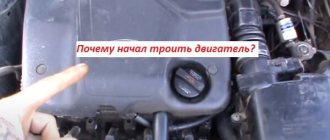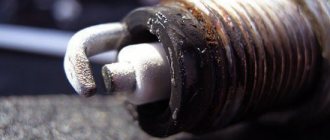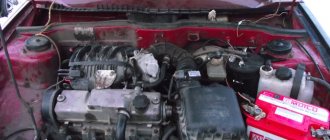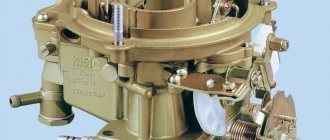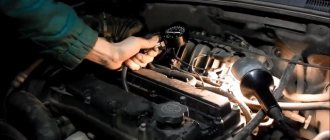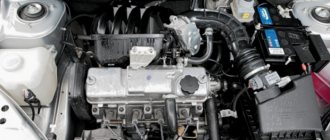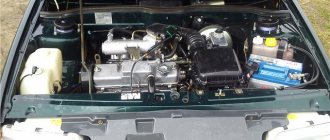General manifestation of the malfunction
Popping noises in the carburetor may appear under the following circumstances:
- after engine repair;
- there was an accident or a pothole on the road;
- tuning or simply adjustment of the carburetor was carried out;
- the car has high mileage.
In this case, a malfunction may occur in the following cases:
- when you press hard on the gas pedal;
- after parking, with a cold engine;
- on the go under load;
- when trying to start the engine.
Depending on the reason that caused the carburetor to shoot, popping noises can appear either abruptly or gradually, increasing in intensity daily. Operating a car when the engine sneezes into the carburetor, in addition to discomfort for the driver, can lead to the need for major engine repairs.
Concurrent symptoms
As a rule, the situation is accompanied by a number of other signs:
- unstable operation of the internal combustion engine in idle mode;
- difficulty starting;
- loss of power and throttle response of the power unit;
- rapid overheating of the motor;
- increase in fuel consumption.
Note also that in such a situation the car accelerates poorly. When you press the accelerator pedal, jerks, dips, and delays appear. The car jerks a lot, especially in transition modes. The power plant does not so much work as “sneeze.”
High voltage wires
When carrying out repairs affecting the ignition system, the high-voltage wires may be connected incorrectly. In this case, the spark will not occur in time with the compression cycle, resulting in popping sounds. Even if the engine starts, its power is not enough to move the car.
To diagnose a malfunction, you should check the connection of the wires from the spark plugs to the distributor. You should push off from the mark located on the cover. The connection of high-voltage wires must correspond to the car model. For example, the location of high-voltage wires in the VAZ 2109 is shown below.
Correct connection of high-voltage wires VAZ 2109
Diagnostics
You can diagnose the condition of the engine and the operation of the fuel system using spark plugs. If the center electrode of the spark plug is white, this indicates that the engine is running on a lean mixture. If the carbon deposits are black and dry, then this indicates a rich mixture.
To eliminate this problem, it is recommended to adjust the carburetor. It is better to use a gas analyzer, since settings that rely on human senses do not always give the desired result. In addition, you need to choose a gas station before buying fuel - sometimes black deposits can form due to the quality of gasoline.
Mixture composition
If the engine is supplied with a too lean or rich mixture, then shooting is also possible. This situation may arise if the carburetor has been adjusted. Incorrect installation of the quality screw leads to incorrect preparation of the air-fuel mixture.
When operating on a lean mixture, the mixture burns slowly. When the intake valve opens, fuel continues to burn out. It ignites a new combustible mixture. Combustion occurs in the intake manifold and the engine shoots into the carburetor. At the same time, an increase in engine temperature is observed.
When working with an enriched mixture, black carbon deposits form on the electrodes. If there is enough plaque and a high temperature, it can ignite the air-fuel mixture at the wrong time. This causes the carburetor to pop as the intake valve is open at this time. This malfunction only appears when the engine is warm. Gradually the engine sneezes more and more often. A significant drop in power in this case is extremely rare.
For diagnosis, you should inspect the spark plugs. The presence of a white color indicates operation on a lean mixture. Black plaque, on the contrary, indicates over-enrichment.
To eliminate the malfunction, the carburetor should be inspected. If adjustment does not help, then flushing is required. You should also be careful about the fuel purchased at gas stations.
Why does the engine shoot into the carburetor: resulting in popping noises
A fairly common problem with carburetor cars is the characteristic popping noise in the carburetor. The malfunction may occur when the engine starts and fires into the carburetor, as well as during operation of the internal combustion engine after the power unit has been started. At the very beginning, we note that experts consider the main reasons to be a severe depletion of the fuel-air mixture, ignition timing, or malfunctions of the gas distribution mechanism associated with incorrectly set phases.
As for the CIS, most carburetor cars on the roads are Russian-made models. Next, we will look at problems when a VAZ engine shoots into the carburetor, why a 406 engine shoots into the carburetor, and also talk about how to detect and fix such malfunctions with your own hands.
Late and early ignition
With late ignition, combustion of the air-fuel mixture occurs throughout the entire power stroke. When the intake valve opens, the burning old mixture ignites fresh fuel. The engine overheats significantly during such operation. Popping noises can be observed not only in the carburetor, but also in the muffler.
For diagnostics, it is recommended to check the set ignition timing and, if necessary, adjust it. Whitened spark plug electrodes serve as indirect evidence of late ignition.
If the spark appears too early, the fuel will not ignite in a timely manner. In this case, the intake valve does not have time to close, and the combustible mixture inside the intake manifold ignites.
Particular attention should be paid to the OZ if work was carried out to repair the ignition system. It is required to produce the moment of sparking. The ignition timing is adjusted by turning the distributor relative to the scale.
Inspection of the ignition timing
What to do if the engine shoots into the carburetor and muffler
The appearance of popping noises in the muffler and carburetor is usually accompanied by a whole list of other symptoms:
- the engine “shoots” and does not start;
- work at XX is extremely unstable;
- the engine loses power and does not “pull”;
- the motor is prone to overheating;
- fuel consumption increases noticeably;
In this case, the unit’s response to pressing the gas pedal is not clear; delays and dips appear; the machine may jerk under load and in transient modes. In the language of ordinary car enthusiasts, the engine begins to “sneeze.” If the carburetor shoots when starting the engine, and the additional symptoms described above are also present, then certain elements and settings should be checked.
Diagnostics of the ignition system and OZ settings
The check should begin with the high-voltage wires of the ignition system. Violating the order of their connection will lead to the fact that the moment of spark formation on the spark plug will not occur at the end of the compression stroke, and the very order of supplying sparks to the cylinders during engine operation will also be disrupted. In this case, the engine may start, but during operation there will be shooting in the carburetor, which will be repeated at certain intervals. To solve the problem, you should connect the wires to the spark plugs, taking into account the fact that there are special marks on the distributor cover. These labels will help you make connections in the correct order.
If the engine shoots into the carburetor, the reason may be early ignition. This means that the spark appears too early. In other words, the mixture does not ignite at the end of the compression stroke, but at the moment the piston begins to approach TDC, completing the stroke.
In this case, the mixture of fuel and air in the cylinder burns untimely, as a result of which the combustion process is disrupted. The result of early combustion is a “lumbago” in the form of a pop in the carburetor. With late ignition, popping noises can go into the muffler, since combustion is still ongoing when the intake valve begins to reopen on the next stroke. Moreover, the combustion of the remaining mixture also extends to a new portion of the fuel charge, which is sucked into the engine from the carburetor into the intake manifold during intake. Under such conditions of disrupted combustion, the engine overheats. Often late or early ignition can be determined by the condition of the spark plugs. If the spark plugs are white, with carbon deposits, etc., then the OZ needs to be checked and set by adjusting the ignition timing. This adjustment is made by turning the distributor in accordance with the scale.
You should also check the Hall sensor and pay attention to the ignition distributor bearing. Problems with bearing fastening or other nuances may indicate the need to replace the distributor. Let us add that during diagnostics it is optimal to install an initially serviceable device on the car, which will allow faster and more accurate localization of faults in the ignition distributor. Similar actions should be performed with the ignition system switch. If it breaks down, sparking is disrupted and the spark itself is not supplied at exactly the specified moment.
Lean mixture: carburetor and fuel system
Running a carburetor engine on a “poor” fuel-air mixture often leads to the formation of pops and shooting in the carburetor. This phenomenon occurs because the lean mixture burns too slowly. The problem resembles an ignition failure, that is, the lean mixture burns after a new intake stroke has begun. It turns out that after exhaust, the intake valve opens on the intake stroke, and the lean fuel mixture still burns out in the combustion chamber. The incoming portion of the mixture also lights up. As a result, cotton is created in the intake, which reaches the mixing chamber of the carburetor itself. It should also be remembered that a lean working mixture is one of the main reasons for engine overheating.
It is also necessary to check at what level the fuel is in the float chamber. Another reason for a lean mixture may be air leaks. At the same time, you should check the carburetor accelerator pump, especially if shooting occurs when you press the accelerator sharply. Note that in most cases, to normalize the operation of the internal combustion engine, it is enough to clean the carburetor with a “carbicleaner” type cleaner and then correctly configure the device, as well as replace the fuel filters.
Timing faults
Special attention will be required in the case where, after carrying out any repair work or as a result of wear of the timing drive elements, shots appear in the carburetor. The most common cause is a stretched, worn or incorrectly installed timing belt. In other words, a phase failure occurred during the operation of the gas distribution mechanism, as a result of which the fuel mixture burns when the intake valves open. In such a situation, you need to accurately align the timing belt according to the marks.
Such a loose fit of the valves to the seats leads to the mixture burning out in the intake manifold and causing shooting in the carburetor. Operating the engine with the valves clamped after a short period of time causes the valve to burn out, since the edges of the plates experience severe temperature loads, the valves do not release excess heat to the cylinder head, etc. The thermal clearances of the valves must be precisely adjusted, and the settings themselves must be checked every 20-40 thousand km. mileage
Finally, let’s add that popping noises in the carburetor can be caused by a burnt-out valve, as well as other defects in the valve mechanism. In this case, the combustion chamber loses its tightness, that is, the valve plate does not completely adhere to the seat in the cylinder head. After the mixture ignites, a breakthrough of hot gases and flame occurs, and the carburetor begins to fire. To accurately determine the condition of the engine, it is necessary to measure the compression in the cylinders. Based on the results obtained and by analyzing other signs of malfunction, a decision should be made as to whether it is advisable to remove the cylinder head for repair.
What's the result?
It is quite obvious that the appearance of popping noises in the carburetor is an alarming symptom that requires immediate identification and elimination of the existing problem. Let us add that shots or pops can quickly damage the carburetor itself, so further operation of the car is not recommended.
If simple methods, such as cleaning the carburetor, adjusting the OZ, replacing high-voltage wires and fuel filters, do not help, then it is necessary to check the timing, measure the compression in the engine and evaluate the overall serviceability of the valve mechanism.
Signs for determining the correct ignition timing. Consequences of an incorrectly configured OZ, methods for setting the ignition.
Features of adjusting the Solex carburetor. How to set the fuel level in the float chamber, adjust the idle speed, select jets, remove dips.
The reasons why, after pressing the gas pedal, dips occur and the engine begins to choke. Gas engine failures when switching from gasoline to gas.
When you sharply press the gas pedal, the engine jerks, jerks and dips appear, the car does not pick up speed: the main causes of the malfunction and diagnostics.
Engine trouble: symptoms. Why does tripping occur and how to find the reason why the motor starts to trip. Checking power, ignition, compression, etc.
The reasons for the appearance of shots and pops in the muffler at different engine operating modes: idling, over-throttle, etc. How to find and fix the problem.
Source
Malfunction of the ignition distributor
A faulty distributor can cause improper ignition of the mixture in the combustion chamber. Its main faults include:
- breakdown of the lid;
- slider failure;
- oxidation at the attachment point of high-voltage wires, causing energy loss.
To identify the distributor as the culprit of the popping noise, it is recommended to install a known-good device in its place. If the shooting disappears, further diagnosis of the ignition distributor malfunction will be required.
Distributor
Adjusting the carburetor ZIL-130 AutoClub ZIL 130
The idle speed system of the ZIL-130 carburetor is adjusted with a fully warmed-up engine and a completely serviceable ignition system using a thrust screw 2 (Fig. 26), which limits the closing of the throttle valves, and two screws 1, which change the composition of the mixture
Particular attention should be paid to the serviceability of the spark plugs and the correct gap between their electrodes. It should be taken into account that the carburetor is a two-chamber carburetor, and the composition of the mixture in one chamber is adjusted with the appropriate screw, regardless of the composition of the mixture in the other chamber. When tightening the screws, the mixture becomes leaner, and when unscrewing, it becomes richer.
Rice. 26. Adjustment of the idle system of the ZIL-130 carburetor: 1 - adjustment screws; 2—thrust screw.
When starting to adjust the ZIL-130 carburetor, you need to tighten the screws all the way, but not too tightly, and then unscrew each three turns. After this, you should start the engine and use the thrust screw to set the throttle opening to the minimum value at which the engine operates quite stably. Then you need to lean the mixture using one of the screws 41 (see Fig. 25), tightening this screw at each test by V4 turns until the engine begins to work with obvious interruptions. Then you should enrich the mixture by turning out screw 41 1/2 turn. After adjusting the mixture composition in one chamber, it is necessary to make adjustments in the second chamber. Having adjusted the mixture composition, you should try to reduce the idle speed by gradually unscrewing the throttle valve thrust screw, after which you should again try to lean the mixture using the screws, as indicated above. Usually, after two or three attempts, you can find the correct position for all three adjusting screws. Do not set the engine idle speed very low. To check the idle speed adjustment, press the throttle pedal and immediately release it sharply. If the engine stops working, the engine idle speed must be increased.
Switch failure
Typically, a breakdown of the switch makes it impossible to start the engine, so popping noises will be observed when trying to start. To diagnose, just install a new device. If the motor stops firing, then the switch needs to be replaced or repaired. What to do depends on the type of breakdown and the capabilities of the car owner.
Very often this malfunction can be detected at an early stage. The engine speed begins to fluctuate, and when you sharply press the gas pedal, the car accelerates with dips in traction. Small popping noises are heard from the engine compartment.
Popping sounds in the carburetor on the 402 engine
The 402 model engine was serially installed on Gazelle cars until 1985, then the Gorky Automobile Plant switched to equipping cars with 406 engines. Now thousands of Gazelles, Volga GAZ-3110 are operated by ZMZ-402. Like any gasoline engine, popping in the carburetor on the 402 engine is a frequent occurrence.
There are a lot of malfunctions that cause lumbago and popping noises. The most widespread of them:
- obstruction of fine gasoline filters and fuel pumps;
- diaphragm rupture, violation of tight fit of fuel pump valves;
- ice plugs in fuel pipes or sump;
- Gasoline supply hoses are clogged with debris;
- the carburetor air damper does not close tightly;
- The passage holes of the idle jet and the main fuel jet are coked with resins and deposits.
Disturbances in the operation of the gas distribution mechanism
Starting the engine will be accompanied by shots into the carburetor if the timing phases are out of whack, that is, the drive has jumped several teeth. In this case, if the shift is 1-2 teeth, the engine will be able to operate, but there will be a loss of power. But with a significant timing shift, the valves can be damaged. In this case, you cannot do without engine repair.
Reasons that cause shift of the gas distribution mechanism drive:
- when performing repair work on the engine, the phases are inattentively set;
- belt replacement;
- low tension, sufficient to cause slippage;
- the car gets into an accident or a pothole;
- Excessive wear of timing elements.
Installation marks for checking the correct timing of timing
To diagnose the malfunction, it is necessary to check the timing marks on the crankshaft pulley and the housing. Troubleshooting depends on the effects of phase shift. In some cases, it is enough to correct the operation of the timing belt, but if the pistons hit the valves, it is impossible to do without repairing the engine.
If you notice a timing shift, you should not try to start the engine, much less apply gas, checking the possibility of travel. Starting the internal combustion engine is possible only after the timing marks have been correctly placed and the cause that caused the shift has been eliminated. Otherwise, the motor may be significantly damaged.
Additional reasons
There are a number of other reasons why the exhaust pipe shoots. These include:
- Popping noises when idling the engine are possible for two reasons - a leak in the intake manifold, as well as a clogged idle system.
- Poor quality gasoline or gasoline with a low octane number. Try to refuel at reputable gas stations and use fuel recommended by the manufacturer of your car.
- Mixed spark plug wires . If, when replacing or checking spark plugs, you mixed up the wires connected to them, this will also be a likely cause of popping noises. In this case, the car may not start and “shoot” at the muffler.
- If your machine has an economizer , check its operation. Often the malfunction of this unit is also the cause of “shots”.
- Malfunction of the air damper . Check this element and adjust if necessary.
- One of the reasons when the muffler shoots when releasing gas is that the muffler downpipe ( “pants” ) is poorly screwed to the exhaust manifold. Check the tightness of the connection and tighten it if necessary.
- Another likely cause of popping noises is high performance fuel injectors (“leaking”). They supply too much fuel, which does not have time to burn completely, which leads to “shots”. There is a simple way to check. It is necessary to try to start the engine at high engine speeds (with the gas pedal depressed) (the so-called purge mode). If popping noises occur at this time, it means that at least one injector is leaking.
- In injection cars, late ignition and, as a result, popping noises can be caused by “fatigue” of the knock sensor . It can also respond to extraneous noises occurring in the engine. The operation of the sensor must be checked using computer diagnostics.
- If the muffler shoots when releasing gas , then one of the most common reasons for this is “burning” of the exhaust valves. Popping noises may also appear when descending a mountain in gear. Inspect and clean them.
- If your car uses a contact ignition system, then you need to check the gap on its contacts . Ignition problems, as described above, may be the reason that not all of the gasoline is burned.
- Leakage of the gas exhaust system . In this case, as a rule, single pops occur when the gas is released. First of all, check the gaskets at the connections of the pipes (catalyst, resonator, muffler).
Also, if lumbago occurs and traction deteriorates, it is recommended to check the fuel pressure in the system, as well as compression (cylinder tightness for leaks), and inspect the ignition coil.
Condensation in the muffler
The main reason for the formation of condensation in the muffler is the temperature difference between the ambient air and the muffler. Its formation in a car with a working catalyst is a natural phenomenon. It’s worse if it’s not there, but too much can cause corrosion. There is a Read more
As you can see, there are many reasons why a muffler shoots. Therefore, we advise you to start your diagnostics by checking the tightness of the exhaust system. Inspect the bolted connections and gaskets between its individual elements. This will save you time and money. This is especially true if popping noises are heard when releasing the gas or when descending a mountain in gear (when braking the engine).
If the audit does not give positive results, then it is necessary to check the operation of the carburetor, valves and other parts described above. This check is advisable if the muffler shoots when you press the gas .
Inlet valve
A bent or burnt valve is unable to seal the combustion chamber from the carburetor. Loose pressure of the plate to the seat allows gases to break into the intake manifold. In some cases, the fresh air-fuel mixture ignites.
To diagnose the problem, you need to check the compression. If a cylinder is detected with a suspected combustion chamber leak, it is necessary to fill it with engine oil. This will prevent excessive wear of the cylinder-piston group or sticking of the piston rings. A cylinder with a damaged valve shows the same compression both with and without oil.
To eliminate the malfunction, it is necessary to dismantle the cylinder head and replace the valve. If the valve is bent, it is recommended to check the correct timing of the timing belt. Burnout of the valve with low mileage also requires searching for the cause of this breakdown.
If you have hydraulic boosters, you should also check their operation. Sticking of the hydraulic compensator leads to the same consequences as burnout of the valve. In this case, shooting into the carburetor may not be observed all the time, but during certain periods, for example, when the engine is cold or hot. Very often, car owners complain that they shoot when I start the engine.
Common reasons why shots and pops occur in the exhaust (carburetor)
- The search for causes should begin with checking the tightness of the exhaust system. A rusted muffler or resonator can cause air to leak, and you will eventually hear something similar to popping noises.
- The second reason may be an increased fuel level in the float chamber of the carb.
- The carburetor float chamber needle valve may be faulty.
- Often the reason lies in a broken float seal or, more simply, in a broken float.
- The channel or air jet of the idle system is clogged.
- Malfunctions in the operation of the economizer can cause shots and pops from the exhaust.
- Irregularities at work.
Unusual car sounds, where they may come from
Oddly enough, spark plugs can also cause the engine to sneeze into the carburetor. But the difference is that the car will still start, unlike if the carburetor itself sneezes.
Also, the VAZ may “sneeze” due to a faulty timing belt. This happens for two reasons: it becomes unusable due to its service life or if a mistake was made during installation - the teeth are crooked and increased wear occurs. This entails serious consequences, including contact of the pistons with the valves. Belt wear can be determined when three components appear: rubbing noises appear, sometimes with a uniform knocking sound, difficult starting, and darkening of the exhaust gases.
If the VAZ 2109 does not start for a long time, another serious problem may appear: the carburetor starting diaphragm wears out. Of course, the car won’t sneeze because of this, but starting it will be very problematic. This problem can be dealt with quite easily, but only temporarily; the diaphragm will eventually have to be replaced. This issue is resolved as follows: using a regular 2-3 millimeter wire, it is necessary to make a gap of 3-4 millimeters between the first chamber and the air damper.
Increased oil consumption
1) The drain plug is not tightened
2) Damaged plug gasket
3) The main bearing cover bolts are loose
4) Damaged main bearing cover gasket
5) Damaged crankshaft oil seal
Insufficient oil viscosity
1) Defective piston rings
2) Jamming of piston rings, their wear or insufficient contact with the cylinder wall
3) Excessive piston and cylinder wear
4) Excessive valve stem wear
5) Excessive oil level
Bring the oil level back to normal
Repair or replace
